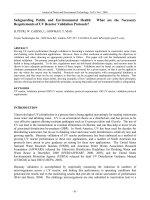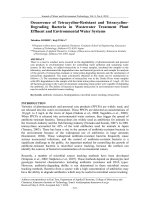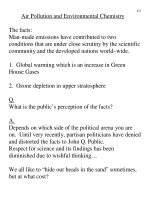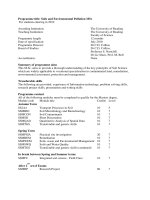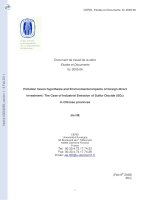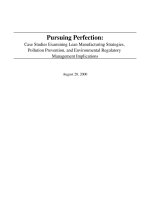Pentachlorophenol: Toxicology and Environmental Fate
Bạn đang xem bản rút gọn của tài liệu. Xem và tải ngay bản đầy đủ của tài liệu tại đây (180.11 KB, 47 trang )
Pentachlorophenol
1. NAME
1.1 Substance
1.2 Group
1.3 Synonyms
1.4 Identification numbers
1.4.1 CAS number
1.4.2 Other numbers
1.5 Main brand names, main trade names
1.6 Main manufacturers, main importers
2. SUMMARY
2.1 Main risks and target organs
2.2 Summary of clinical effects
2.3 Diagnosis
2.4 First-aid measures and management principles
3. PHYSICO-CHEMICAL PROPERTIES
3.1 Origin of the substance
3.2 Chemical structure
3.3 Physical properties
3.3.1 Colour
3.3.2 State/Form
3.3.3 Description
3.4 Hazardous characteristics
4. USES
4.1 Uses
4.1.1 Uses
4.1.2 Description
4.2 High risk circumstance of poisoning
4.3 Occupationally exposed populations
5. ROUTES OF EXPOSURE
5.1 Oral
5.2 Inhalation
5.3 Dermal
5.4 Eye
5.5 Parenteral
5.6 Other
6. KINETICS
6.1 Absorption by route of exposure
6.2 Distribution by route of exposure
6.3 Biological half-life by route of exposure
6.4 Metabolism
6.5 Elimination and excretion
7. TOXICOLOGY
7.1 Mode of Action
7.2 Toxicity
7.2.1 Human data
7.2.1.1 Adults
7.2.1.2 Children
7.2.2 Relevant animal data
7.2.3 Relevant in vitro data
7.2.4 Workplace standards
7.2.5 Acceptable daily intake (ADI)
7.3 Carcinogenicity
7.4 Teratogenicity
7.5 Mutagenicity
7.6 Interactions
8. TOXICOLOGICAL ANALYSES AND BIOMEDICAL
INVESTIGATIONS
8.1 Material sampling plan
8.1.1 Sampling and specimen collection
8.1.1.1 Toxicological analyses
8.1.1.2 Biomedical analyses
8.1.1.3 Arterial blood gas analysis
8.1.1.4 Haematological analyses
8.1.1.5 Other (unspecified) analyses
8.1.2 Storage of laboratory samples and specimens
8.1.2.1 Toxicological analyses
8.1.2.2 Biomedical analyses
8.1.2.3 Arterial blood gas analysis
8.1.2.4 Haematological analyses
8.1.2.5 Other (unspecified) analyses
8.1.3 Transport of laboratory samples and specimens
8.1.3.1 Toxicological analyses
8.1.3.2 Biomedical analyses
8.1.3.3 Arterial blood gas analysis
8.1.3.4 Haematological analyses
8.1.3.5 Other (unspecified) analyses
8.2 Toxicological Analyses and Their Interpretation
8.2.1 Tests on toxic ingredient(s) of material
8.2.1.1 Simple Qualitative Test(s)
8.2.1.2 Advanced Qualitative Confirmation Test(s)
8.2.1.3 Simple Quantitative Method(s)
8.2.1.4 Advanced Quantitative Method(s)
8.2.2 Tests for biological specimens
8.2.2.1 Simple Qualitative Test(s)
8.2.2.2 Advanced Qualitative Confirmation Test(s)
8.2.2.3 Simple Quantitative Method(s)
8.2.2.4 Advanced Quantitative Method(s)
8.2.2.5 Other Dedicated Method(s)
8.2.3 Interpretation of toxicological analyses
8.3 Biomedical investigations and their interpretation
8.3.1 Biochemical analysis
8.3.1.1 Blood, plasma or serum
8.3.1.2 Urine
8.3.1.3 Other fluids
8.3.2 Arterial blood gas analyses
8.3.3 Haematological analyses
8.3.4 Interpretation of biomedical investigations
8.4 Other biomedical (diagnostic) investigations and their interpretation
8.5 Overall Interpretation of all toxicological analyses and toxicological
investigations
8.6 References
9. CLINICAL EFFECTS
9.1 Acute poisoning
9.1.1 Ingestion
9.1.2 Inhalation
9.1.3 Skin exposure
9.1.4 Eye contact
9.1.5 Parenteral exposure
9.1.6 Other
9.2 Chronic poisoning
9.2.1 Ingestion
9.2.2 Inhalation
9.2.3 Skin exposure
9.2.4 Eye contact
9.2.5 Parenteral exposure
9.2.6 Other
9.3 Course, prognosis, cause of death
9.4 Systematic description of clinical effects
9.4.1 Cardiovascular
9.4.2 Respiratory
9.4.3 Neurological
9.4.3.1 Central nervous system (CNS)
9.4.3.2 Peripheral nervous system
9.4.3.3 Autonomic nervous system
9.4.3.4 Skeletal and smooth muscle
9.4.4 Gastrointestinal
9.4.5 Hepatic
9.4.6 Urinary
9.4.6.1 Renal
9.4.6.2 Others
9.4.7 Endocrine and reproductive systems
9.4.8 Dermatological
9.4.9 Eye, ears, nose, throat: local effects
9.4.10 Haematological
9.4.11 Immunological
9.4.12 Metabolic
9.4.12.1 Acid-base disturbances
9.4.12.2 Fluid and electrolyte disturbances
9.4.12.3 Others
9.4.13 Allergic reactions
9.4.14 Other clinical effects
9.4.15 Special risks
9.5 Other
9.6 Summary
10. MANAGEMENT
10.1 General principles
10.2 Life supportive procedures and symptomatic treatment
10.3 Decontamination
10.4 Enhanced elimination
10.5 Antidote treatment
10.5.1 Adults
10.5.2 Children
10.6 Management discussion
11. ILLUSTRATIVE CASES
11.1 Case reports from literature
12. ADDITIONAL INFORMATION
12.1 Specific preventive measures
12.2 Other
13. REFERENCES
14. AUTHOR(S), REVIEWER(S), DATE(S) (INCLUDING UPDATES),
COMPLETE ADDRESS(ES)
PENTACHLOROPHENOL (PCP)
International Programme on Chemical Safety
Poisons Information Monograph 405
Chemical
1. NAME
1.1 Substance
Pentachlorophenol
1.2 Group
Phenol
1.3 Synonyms
2,3,4,5,6-pentachlorophenol,
Chlorophen,
PCP,
Penchlorol,
Penta,
Pentachlorofenol,
Pentachlorofenolo,
Pentachlorphenol,
Pentaclorofenol,
Pentanol,
1.4 Identification numbers
1.4.1 CAS number
87-86-5 (Sodium pentachlorophenate)
1.4.2 Other numbers
UN number: 2020
1.5 Main brand names, main trade names
Acutox; Chen-pentas; Chem-Tol; Cryptogil ol; Dowicide 7;
Dowicide EC-7; Dow Pentachlorophenol DP-2 Antimicrobial;
Durotox; EP 30; Fingifen; Fongol; Glazd Penta; Grundier
Arbezol; Jimo-Cupim; Lauxtol; Lauxtol A; Liroprem; Moosuran;
NCI-C 54933; NCI-C 55378; Pentacon; Panta-Kil; Pentasol;
Penta-Kill; Penwar; Peratox; Permacide; Permagad; Permasan;
Permatox; Priltox; Permite; Santopen; Satophen 20; Sinituho;
Term-i-trol; Thompson's Wood Fix; Weedone; Withophen P;
Withophen N.
1.6 Main manufacturers, main importers
To be completed by each centre.
2. SUMMARY
2.1 Main risks and target organs
The main risks in acute poisoning are: hyperpyrexia, tachycardia, and a rise in the metabolic
rate leading to death by cardiac arrest. In chronic exposure, the main riss are: skin, blood,
neurological and respiratory disorders, porphyria, non-specific symptoms, and the possibility of
cancer.
Target organs are: skin, respiratory system, central nervous system (CNS), liver and kidneys, but
especially metabolism at the cellular level.
2.2 Summary of clinical effects
Symptoms of acute systemic poisoning are: headache, profuse sweating, depression,
nausea, weakness, and sometimes fever; tachycardia, tachypnea, pain in the chest, thirst.
Abdominal colic is frequent. Mental distress can occur, progressing to coma and occasionally
convulsions; irritation of the skin, mucous membranes, and respiratory tract (including painful
irritation of the nose and intense sneezing when pentachlorophenol is inhaled); contact dermatitis
and chloracne.
Chronic exposure can cause: porphyria cutanea tarda, weight loss, increased basal
metabolic rate, functional changes of the liver and kidneys. Insomnia and vertigo have also been
reported.
2.3 Diagnosis
Symptoms of acute poisoning include abdominal pain, headache, profuse sweating,
depression, nausea, weakness.
Less commonly, fever; tachycardia, tachypnea, chest pain and thirst occur. Symptoms
may progress to coma and occasionally convulsions.
Other effects include irritation of the skin, mucous membranes, and respiratory tract (including
painful irritation of the nose and intense sneezing after inhalation); contact dermatitis and
chloracne.
Routine blood biomedical analysis, especially electrolytes, acid-base balance; hepatic
enzymes; creatinine and BUN; blood elements.
Toxicity occurs above 1 mg/l and symptoms become obvious at approximately 40 mg/l.
Urine: urine analysis (strict measurement of kidney function); porphyrines, delta-
aminolevulinic acid. Toxicity is evident at urinary concentrations of 1 mg/l or more.
2.4 First-aid measures and management principles
Remove the patient from exposure
Admit the patient to hospital (decontaminate patient before admission, if possible).
Decontaminate eyes with large amounts of water.
If patient is alert or has a coughing reflex:
Perform gastric lavage with water or saline isotonic solution or 5% sodium bicarbonate
using a cuffed endotracheal tube. However, caution is needed since the solvents of PCP products
are usually petroleum distillates.
Give activated charcoal, 30 to 50 g in 200 ml water.
Control fever by physical means: sponge or tepid bathing or covering the patient with low-
temperature blankets.Aspirin or other antipyretics are likely to enhance the toxicity of phenolic
compounds.
If the patient is unconscious:
Provide a clear airway and respiratory assistance.
Treat symptomatically. Maintain blood pressure.
Give intravenous fluids (watch for cerebral oedema).
Give diazepam intravenously to control convulsions.
Haemodialysis and haemoperfusion may be considered.
No specific antidote is known.
3. PHYSICO-CHEMICAL PROPERTIES
3.1 Origin of the substance
Synthetic
PCP is produced by two methods: direct chlorination of phenol; and hydrolysis of
hexachlorbenzene.
Direct chlorination is performed in two steps: liquid phenol, chlorophenol, or
polychlorophenol is bubbled with chlorine gas at 30-40°C, to produce 2,4,6-trichlorophenol,
which is then converted to PCP by further chlorination at a higher temperature in the presence of
catalysts (aluminium, antimony and their chlorides). The second method involves alkaline
hydrolysis of hexachlorobenzene (HCB) in methanol and dihydric alcohols, water, and solvents at
130-170°C. Numerous by-products are created, in addition to PCP.
Toxic by-products are chlorinated esters, dibenzofurans, and di-benzo-p-dioxines; HCB is also
produced by the second method (WHO, 1987).
3.2 Chemical structure
Formula: CHC10 C1 C16 5 C1 OH C1 C1
Molecular weight: 266.3
Note: The sodium salt (Na-pentachlorophenate) has a different formula and solubility, but the
toxic effects are the same.
3.3 Physical properties
3.3.1 Colour
3.3.2 State/Form
3.3.3 Description
Boiling point: 309-310° C (decomposition at 754 mm)
Melting point: 191° C
Density (g/ml):1.987
Vapour pressure kPa (mmHg at 20° C)2 × 10-6
(1.5 × 10-5)
Saturation vapour density: 250 mg/m3 (20° C)
Steam volatility: 0.167 (g/100 g water vapour at
100°C)
Solubility in fat g/kg 213(37° C):
n-Octanol-water partition coefficient (log P)
4.84 pH 1.2 3.56 pH 6.5 3.32 pH 7.2 3.86 pH 13.5 pK
(25° C):4.7
Solubility in water:
(g/100 ml at 20° C) 0.014pH=5 2pH=7 8pH=8 1pH=15
Solubility in organic acetone 50 solvents (g/100 g
atbenzene 15 25°C) ethanol 95% 120 ethylene glycol 11
isopropanol 85 methanol 180
3.4 Hazardous characteristics
Pure pentachlorophenol consists of light tan to white, needle-like crystals.
It has a pungent odour when heated.
Its vapour pressure indicates that it is relatively volatile even at ambient temperature.
The substance decomposes on heating in the presence of water, forming corrosive fumes
(hydrochloric acid).
Pentachlorophenol is non-flammable and non-corrosive in its unmixed state, whereas its
solution in oil causes rubber to deteriorate.
Formulated products may be flammable.
Due to nucleophilic reactions of the hydroxyl group, pentachlorophenol can form esters
with organic and inorganic acids and ethers with alkylating agents such as methyl iodide and
diazomethane.
Due to electron withdrawal by chlorine atoms in the benzene ring, pentachlorophenol
behaves as an acid, yielding water-soluble salts such as sodium pentachlorophenate.
Pentachlorophenol occurs in two forms: the anionic phenolate at neutral to alkaline pH; and the
undissociated phenol at acidic pH.
Odour threshold (mg/l) 1.6 (in water).
Olfactory threshold (mg/l) 0.03 (in water).
Technical grade pentachlorophenol contains many impurities, depending on the
manufacturing method used. These impurities consist of other chlorophenols and several
microcontaminants, mainly polychlorodibenzodioxins (PCDDs), polychlorodibenzofurans
(PCDFs), and polychlorinated biphenyls (PCBs).
Since the toxicity of PCDDs and PCDFs mostly depends not only on the number but also
on the position of chlorine substituents, an accurate characterization of PCP impurities is needed.
The highly toxic 2,3,7,8-tetrachlorodibenzo-p-dioxin (TCDD) has only been confirmed once in
commercial PCP samples. The higher PCDDs and PCDFs are more characteristic of PCP
formulations.
Hexachlorodibenzo-p-dioxin (H6CDD), which is also considered highly toxic and
carcinogenic, and octachlorodibenzo-p-dioxin(CDD), are present in relatively high amounts in
unpurified technical grade PCP. Hexachlorobenzene is also found at levels of 400 mg/kg in
commercial grade PCP.
The comparative toxicity of technical versus pure PCVP needs to be clearly established.
There is a need for specification of a technical PCP (WHO, 1987).
Chemical activity and reactivity:
Pentachlorophenol forms salts with alkaline metals; sodium pentachlorophate is
converted exothermically to octachlorodibenzo-para-dioxin at 360°C; heating of the sodium salt
to 280°C produces 0.9 mg/kg octa-chlorodibenzo-para-dioxins and 0.3 mg/kg hepta-
chlorodibenzo-para-dioxins, together with 0.02 to 0.03 mg/kg hexa-, penta-, and tetra-
chlorodibenzo-para-dioxins.
Volatilization can be an important source of PCP from water and soil surfaces as well as from
PCP treated materials. The pH seems to be the major factor that controls the extent of PCP
absorption: absorption is maximal in strongly acidic soils.
Leaching of PCP occurs more easily in alkaline soils than in acidic soils. PCP is subject
to abiotic (photochemical) degradation in water, organic solvents, and on solid surfaces.
There are many fungi and bacteria that attack PCP and cause biotic degradation in water and
soil.
4. USES
4.1 Uses
4.1.1 Uses
4.1.2 Description
The main advantages of PCP and its salts are that they are very effective biocides
that have a broad application and are inexpensive.
PCP and its derivatives have a variety of applications in agriculture, industry, and
domestic fields.
Their major application is wood preservation, particularly on a commercial scale.
They protect construction lumber, and also poles and posts, from fungal rots and decay. They also
prevent staining.
PCP is also used as a herbicide, defoliant, fungicide, pre-harvest dessicant,
bactericide, insecticide, and molluscicide and to control termites.
PCP has many registered industrial uses. It is used in construction of boats and buildings, to
control mould in petroleum drilling and production, and in the treatment of cable coverings,
canvas belting, nets, and construction lumber and poles. It is used in paints, pulp stock, pulp, and
paper, and to cool tower water, and as preservative for hard board and particle board.
Because of increased concern about the potential health hazard from PCP and its impurities, the
pattern of use has changed in the last few years.
PCP is used in the home, both indoors and outdoors, mostly to treat wood. It is the main active
ingredient in certain wood preservatives used in the home, and is added to products such as stains
and paints. Cases of apparent PCP intoxications after indoor application in homes have been
reported. (Its indoor use is forbidden in some countries, e.g., the Netherlands).
Other applications of PCP include health-care products and disinfectants for the
home, farms, and hospital. PCP may also be contained in dental- and skin-care products, bacterial
soaps, and laundry products.
4.2 High risk circumstance of poisoning
Occupational exposure (most cases): PCP is used to protect wood and in other cellulose products
(see section
4.3).
Accidental exposure to PCP as a result of its application in the interior of homes or in PCP-
treated wood houses. PCP-contaminated food or water, and improper laundering of diapers and
bedding with soap that contains pentachlorophenate.
Suicide attempts with PCP.
In fires, the thermal decomposition of PCP or NaPCP may yield significant amounts of
polychlorinated dibenzo-dioxines (PCDD) and dibenzofurans (PCSF) (WHO, 1987).
4.3 Occupationally exposed populations
Workers involved in:
Manufacture, packaging, labelling, storage, and shipping of PCP.
Application of PCP to wood (wood-immersion, painting).
Sawmills.
Carpentry and other timber and wood-working.
Knapsack sprayers (e.g., termite control, agricultural pesticides).
Greenhouses.
Walking with bare feet through areas where PCP was sprayed.
Addition of PCP to cellulose products, such as starches and adhesives.
Addition of PCP to leather, oils, paints, latex, and rubber.
Manufacture of herbicides.
Industrial cooling towers and evaporative condensers.
Treatment and handling of wood, burlap, canvas, rope, leather, and manufacture of paper.
Petroleum and other drilling.
Manufacture and use of paints and adhesives.
Telephone and electrical line work.
Dyeing and cleaning of garments.
5. ROUTES OF EXPOSURE
5.1 Oral
PCP is readily absorbed by the gastrointestinal tract and reaches peak plasma levels in 4 h.
Absorption is faster when PCP is dissolved in alcohol (WHO, 1987).
Measurements of PCP in the air, water, food, drugs, and consumer products confirm that nearly
every environmental area is contaminated with low levels of PCP.
For workers using PCP, the major routes of absorption are dermal and inhalation.
5.2 Inhalation
Inhalation is one of the two major routes of absorption in the workplace. (Dermal absorption is
the other major route).
Although no experimental data are available on absorption by inhalation, the cases of acute
intoxication reported are almost exclusively due to inhalation and dermal contact with high doses
of PCP (WHO, 1987).
Fine dusts and sprays of PCP or chlorophenate cause painful irritation to the upper respiratory
tract and eyes. This intense pain is an excellent warning sign. If it affects the nose, it will alert
the person to avoid further exposure which might produce adverse systemic effects. Workers
exposed to concentrations of 1 mg/m3 or more have reported painful nasal irritation.
5.3 Dermal
Dermal absorption is the major route of absorption in the workplace. (Inhalation is the other
major route). PCP is readily absorbed through the skin.
A case of skin absorption was reported where a high PCP level in the urine was found after a
worker had cleaned a paintbrush for only 10 min in a can that contained a 4% solution of PCP
(Benvenue et al 1967). Workers handling
PCP-treated lumber absorb from one-half to two-thirds of the total PCP accumulation through
the skin.
These exposures result in low quantities of PCP in the serum and urine of occupationally exposed
persons. Improvements in industrial hygiene can reduce PCP concentrations in the urine.
5.4 Eye
PCP causes painful irritation of the eyes. No data are available on the importance of the eyes as a
route of entry.
5.5 Parenteral
The subcutaneous or intraperitoneal injection of C14-PCP has been used in autoradiographic
studies of PCP distribution in animals (WHO, 1987).
5.6 Other
No data are available.
6. KINETICS
6.1 Absorption by route of exposure
PCP is efficiently absorbed through the skin, the lungs, and the gastrointestinal tract.
In human volunteers, the observed half-life for absorption was about 1.3 h and the peak
plasma level occurred 4 h after ingestion. Absorption was enhanced when PCP was dissolved in
alcohol (WHO, 1987).
For the general population, the uptake of PCP by the oral route is the most important. In
the workplace, or in PCP-treated dwellings, the major routes of absorption are probably the
dermal and inhalation routes (WHO, 1987).
6.2 Distribution by route of exposure
Usually, the highest PCP levels can be found in the urine immediately after exposure.
Consequently, the PCP concentrations in the tissues account for only a small fraction of the PCP
dose.
Experimental studies do not show a uniform distribution pattern of PCP, but indicate that
very high levels can be found in the liver and kidneys. After chronic exposure, most PCP is
absorbed by the central nervous system. In rats, the amount of PCP that crosses the placenta is
very low.
There is an indication that, due to enterohepatic circulation, conjugated PCP is transferred
to the gall bladder and bile.
Autopsies performed in people who have died from PCP intoxication show that PCP levels in the
liver, kidneys, and lungs are often elevated. The high levels in the lungs might be caused by
uptake of PCP by inhalation. In general, PCP levels in various tissues do not clearly indicate
accumulation of PCP, because PCP levels in the blood are often similar to the levels in the tissues
(WHO, 1987).
6.3 Biological half-life by route of exposure
PCP is readily absorbed through the skin as well as through the respiratory and gastrointestinal
tracts. In animals, the half-life for oral absorption varies from 1.8 to
3.6 h in monkeys to 0.36 to 0.46 h in rats.
In human volunteers, the observed half-life for oral absorption is about 1.3 h (WHO,
1987).
Estimates of the elimination half-life vary. One study found the half-life of PCP in plasma
was about 30 h, while that for PCP and PCP glucuronide elimination in the urine was 33 and 13 h,
respectively (WHO, 1987).
In a further study, an elimination half-life of 17 days was calculated from measuring PCP
in both urine and blood (Uhl et al 1986).
6.4 Metabolism
In animals, PCP is excreted unchanged and as metabolites which include
tetrachlorhydroquinone and glucuronides. In man, PCP is eliminated both unchanged and as the
glucuronide. In one study, tetrachlorhydroquinone was found in the urine of two spray-men who
were occupationally exposed. This metabolic transformation was confirmed in liver homogenates
in humans and rats (WHO, 1987).
6.5 Elimination and excretion
PCP is rapidly eliminated by most animals. It is cleared from the plasma by distribution to
the tissues and by excretion via the urine and the faeces; the metabolites, when produced, are also
excreted rapidly.
The PCP concentration in human urine has been widely used as an indicator of the PCP
body burden, based on the fact that, in man, renal excretion of PCP is the major elimination
route. Volunteers excreted 74% of the total dose in urine as PCP, and 12% as PCP glucuronide.
About 4% of the total dose as eliminated in the faeces. In samples taken from non-occupationally
exposed people, two-thirds of the PCP detected in the urine was conjugated.
Ninety-nine per cent of PCP in rat plasma is bound to protein. Human plasma has high
binding capacity (96%) that could explain the long retention times in humans. After a single oral
dose was given to volunteers, the maximum urinary excretion was reached 40 h after ingestion
and 37 h after the maximum plasma level of PCP. This delay is due to a marked enterohepatic
circulation. The elimination half-life of PCP from plasma was about 30 h, while that for PCP and
PCP glucuronide elimination in the urine was 33 and 13 h, respectively (WHO, 1987).
In a further study, an elimination half-life of 17 days was calculated from measuring PCP in both
urine and blood (Uhl et al 1986).
7. TOXICOLOGY
7.1 Mode of Action
As with other chlorophenols, the biochemical action of pentachlorophenol is active
uncoupling of oxidative phosphorylation. The molecular basis for this is not clear.
PCP binds to mitochondrial protein and inhibits mitochondrial ATP-ase activity. Thus,
both the formation of ATP and the release of energy to the cell from the breakdown of ATP to
ADP are prevented. Electron transport is not inhibited by PCP, although reactions dependent on
available high-energy bonds, such as oxidative and glycolytic phosphorylation, are affected.
Binding to enzymic protein has ben reported and may lead to the inhibition of other cellular
enzymes. There is an increase in cellular oxygen demand during theuncoupling of oxidative
phosphorylation. This causes the initial rise in respiration rate reported in individuals poisoned by
PCP. PCP is toxic to the liver, kidneys, and central nervous system.
The toxicity of PCP is increased by impurities in some formulations. In some instances, it is very
difficult to know whether the impurities have affected the poisoning. Dermatitis and chloracne are
caused by contaminants such as PCDDs and PCDFs.
7.2 Toxicity
7.2.1 Human data
7.2.1.1 Adults
In humans, the minimum lethal oral dose (LDLo) has been estimated at 29 mg/kg body weight
(Ahlborg and Thunberg, 1980). Braun et al (1979) reported the ingestion of 0.1 mg/kg PCP by 4
volunteers with no clinical effects. It is generally agreed that the symptoms and signs of acute
chlorophenol toxicity result from the effects of the chlorophenol molecule itself, rather than from
the microcontaminants. Chlorophenol rapidly causes hyperthermia, profuse sweating and early
death. These signs are not observed in animals exposed only to PCDD and PCDF.
Blair (1961) reported several deaths. Levels of PCP were 5.9-6.2 mg/100 g in the liver, and 4.1-
8.4 mg/100 g in kidney tissue. PCP levels in the blood were 5.3-9.6 mg/100 ml and in urine, 2.8
mg/100 ml.
PCP-contaminated diapers caused 20 cases of intoxication, with two fatalities. The concentration
of PCP in the diapers ranged from 109-172 ppm and serum levels of PCP ranged from 7 to 118
ppm (Armstrong et al 1969).
According to a study of post-mortem samples, PCP was found in urine in concentrations of 28-
96 ppm (Bevenue and Beckman, 1967). Haley (1977) reported a case of intentional intoxication
with PCP. The serum level of PCP was 150 ppm 5 h after ingestion, and 28 ppm 2 weeks later.
PCP in the urine showed marked variation during forced diuresis (from 2.3 ppm to 8.6 ppm).
Studies designed to examine biochemical changes in woodworkers exposed to high levels of PCP
for extended periods did not show statistically significant organic effects. Chronic exposure
leading to blood concentrations as high as 4 ppm is likely to cause borderline effects.
Several epidemiological studies from Sweden and the United States have associated soft tissue
sarcomas with occupational exposure to PCP. Surveys from Finland and New Zealand havenot
confirmed this relationship. There are no conclusive reports of increased incidence of cancer in
workers specifically exposed to PCP.
7.2.1.2 Children
Fatal poisoning of infants was traced to improper laundering of diapers and bedding with material
containing Na-pentachlorophenate and other phenols (Armstrong et al, 1969).
No other data are available.
7.2.2 Relevant animal data
ACUTE TOXICITY (LD50) OF PCP
Animal Sex Dose Route Reference
Rat F 210+a Oral Deichman et al, 1942
Rat F 66.3 Subcut Deichman et al. 1942
Rat F 77.9 ++b Oral Deichman et al. 1942
Rat M 149 Derm Noakes et al. 1969
Rat M 146 ++ Oral Gaines, 1969
Rat M 320 ++ Derm Gaines, 1969
Rat 11.7 Inh Hoben et al. 1976
Mouse 130 Oral Pleskoma et al. 1959
Mouse 261 Derm Pleskoma et al. 1959
Mouse 63 Subcut Pleskoma et al. 1959
Mouse 29 Ip Pleskoma et al. 1959
Guinea-pig 100 Oral Knudsen et al. 1974
Sheep 120 Oral Knudsen et al. 1974
a + PCP in aqueous solution
b ++ PCP in oil solution
The no-observed-adverse-effect-levels (NOAELs)
determined in rats that were given pure technical and
purified technical grades of PCP orally were about 2
mg/kg per day.
7.2.3 Relevant in vitro data
Not available.
7.2.4 Workplace standards
The TLV-TWA (Threshold Limit Value-Time Weighted Average) of the 1986-1987
ACGIH (American Conference of Governmental Industrial Hygienists), including the potential
exposure by the cutaneous route, is 0.5 mg/m3.
Time Weighted Average OSHA 0.5 mg/m3 (skin) Short-term Exposure Limit ACGIH 1.5 mg/m3
Maximum Allowable Concentration (USSR) 0.1 mg/m3
7.2.5 Acceptable daily intake (ADI)
Exposure Limit Values
Medium Country/Organization Exposure description
Value Limit
Air Japan NACO.5 mg/m3
Workplace Sweden RECL 8 h TWA 0.5 mg/m3 STEL 1.5 mg/m3
Workplace United Kingdom RECL 8 h TWA 0.5 mg/m3 STEL -10 m TWA 1.5 mg/m3
Medium Country/Organization Exposure descriptiona Value Limit
Workplace Federal Republic of Germany MAC - 8 h TWA 0.5 mg/m3
"USA TLV 0.5 mg/m3 STEL1.5 mg/m3 PEL -TWA 0.5 mg/m3" Italy TLV 0.5 mg/m3
"USSR MAC ceiling value 0.1 mg/m3
Ambient air USSR MAC (1x per day) 0.02 mg/m3 (average per day) 0.005 mg/m3 PSL (1x per
day) 0.001 mg/m3
Food USAADI3 mg/kg body weight/Food plant Federal Republic of Germany MRL 0.01-
0.03mg/kg
Surface water USSR MAC 0.01 mg/l Drinking water WHOMAC (guideline) 10 mg/l
MAC = Maximum allowable concentration
SREL = Short-term exposure limit
PEL = Permissible exposure limit
PSL = Preliminary safety limits
MRL = Maximum residue limit
TWA = Time-weighted average
RECL = Recommended limit
TLV = Threshold limit value
ADI = Acceptable daily intake
The ADI (acceptable daily intake) of PCP levels established by the Safe Drinking
Water Committee of the National Academy of Sciences (USA) is 3 mg/kg body weight per day
(not to be confused with the ADI established by FAO-WHO. PCP has been detected in the serum,
urine, adipose tissues, and even the seminal fluid of the general population. The overall ambient
exposure of an average person not occupationally exposed to PCP is about 26.3 mg/kg/day (6
mg in food, 14mg in water, 4.3 mg in air, and 2 mg miscellaneous sources). The total exposure
corresponds to a dose of 0.438 mg/kg body weight per day for a 60-kg person, which is below the
experimental threshold dose and below the acceptable daily intake of PCP (3 mg/kg/day).
In isolated instances, PCP exposure can be very high, causing acute and subacute intoxications of
the skin and respiratory and digestive tracts.
7.3 Carcinogenicity
Exposure to wood treated with PCP has been associated with an increased incidence of
Hodgkin's Disease (Greene et al, 1978) and non-Hodgkin's lymphoma (Bishop and Jones, 1981).
There is epidemiological evidence that occupational exposure to mixtures of chlorophenols
increases the risk of soft tissue sarcoma and lymphoma, but there is no clear dose-effect
relationship. The major deficiency in all of these studies appears to be a lack of specific exposure
data, with the ever-present problem of impurities (WHO, 1987).
7.4 Teratogenicity
The pregnancy outcomes in 43 women married to sawmill workers in Canada did not reveal any
significant differences when compared with a control group (Corddry, 1981). Teratogenicity has
been reported in animals (WHO, 1987) and PCP is considered to have a potentially deleterious
effect on the human fetus.
7.5 Mutagenicity
The available data are inadequate. Studies have indicated that people exposed to PCP have a
slightly higher rate of chromosome breakage than controls.
7.6 Interactions
Workplace exposures are to technical PCP which usually contains miocrocontaminants,
particularly polychlorinated dibenzo-p-dioxins (PCDDs) and polychlorinated dibenzo-furans
(PCDFs), of which H6CDD is the most important conveyer toxicologically. Subacute effects
such as chloracne and animal hepatotoxicity, fetotoxicity, and immunotoxicity are probably
caused by these contaminants.
The metabolic transformation of other chlorinated compounds, such as hexachlorobenzene,
pentachloronitrobenzene, and gamma benzene hexachloride isomers (e.g., lindane) results in the
formation of PCP (WHO, 1987).
No specific interaction has been reported. The concomitant administration of, or
exposure to, chemicals such as dinitrophenols which increase the metabolic rate, may have
synergistic effects, The use of formulations with solvents based on petroleum distillates
enhances absorption. Hepatotoxic and nephrotoxic chemicals are additional hazards.
8. TOXICOLOGICAL ANALYSES AND BIOMEDICAL INVESTIGATIONS
8.1 Material sampling plan
8.1.1 Sampling and specimen collection
8.1.1.1 Toxicological analyses
8.1.1.2 Biomedical analyses
Serum or blood (e.g. lithium heparinate) and urine (spontaneous) and 24 h
fraction.
8.1.1.3 Arterial blood gas analysis
Heparinized arterial blood sample
8.1.1.4 Haematological analyses
Blood (e.g. EDTA) for routine haematological analyses
8.1.1.5 Other (unspecified) analyses
No further materials.
8.1.2 Storage of laboratory samples and specimens
8.1.2.1 Toxicological analyses
Keep samples in the refrigerator at 4°C until they are analyzed. Urine samples
can be stored up to 40 days if kept deep frozen.
8.1.2.2 Biomedical analyses
Keep samples in the refrigerator at 4°C until they are analyzed. Urine samples
can be stored up to 40 days if kept deep frozen.
8.1.2.3 Arterial blood gas analysis
8.1.2.4 Haematological analyses
8.1.2.5 Other (unspecified) analyses
8.1.3 Transport of laboratory samples and specimens
8.1.3.1 Toxicological analyses
The samples should be transported immediately after collection. They should be
cooled about 4°C.
8.1.3.2 Biomedical analyses
The samples should be transported immediately after collection. They should be
cooled about 4°C.
8.1.3.3 Arterial blood gas analysis
8.1.3.4 Haematological analyses
8.1.3.5 Other (unspecified) analyses
8.2 Toxicological Analyses and Their Interpretation
8.2.1 Tests on toxic ingredient(s) of material
8.2.1.1 Simple Qualitative Test(s)
a) Colour reaction with nitric acid and tetrabase (Feigl 1966)
(1) Principle of test
Pentachlorophenol is easily converted to yellow chloranil (tetrachloro-p-
benzoquinone) by brief warming with concentrated nitric acid. The resulting chloranil is detected
by means of a citric acid solution of tetrabase buffered with sodium acetate. A blue oxidation
product of tetrabase results. If only small amounts of pentachlorophenol are suspected, the nitrous
acid or nitrogen oxides must be destroyed by adding urea to prevent oxidation of the tetrabase.
(2) Sampling
Take a small quantity of the suspect material.
(3) Chemicals and reagents
Chemicals: (Analytical grade)
Concentrated nitric acid, 65% (RD 1,40)
Citric acid
Sodium acetate
Tetrabase, N,N,N',N',
Tetramethyl-4,4'-diaminodiphenylmethan (CAS
Nr. 101-61-1)*
Urea
Pentachlorophenol
Methanol
Reagents:
Tetrabase solution:
250 mg tetrabase and 1,0g citric acid are dissolved in 10 mL water and diluted
with water to 50 mL.
(4) Equipment
Micro test tubes
Water bath
Volumetric flask 50 mL
(5) Sample preparation
Dissolve a small portion (about 50 to 100mg) of the suspect material in 5 mL
methanol; filter or centrifuge if necessary.
(6) Procedure
1. Place one drop of the test solution in a micro test tube and evaporate to
dryness in a boiling water bath.
2. Add one drop of concentrated nitric acid and place for 2 min in the boiling
water bath.
3. Cool the test tube.
4. Add several mg of urea, followed by a drop of the tetrabase solution and a
pinch (tip of knife blade) of solid sodium acetate.
5. Heat the mixture in the boiling water bath for 2 min.
6. A blue colour indicates the formation of chloranil and hence the presence of
pentachlorophenol in the sample.
* Supplier e.g. Alrich Chemie GmbH, D-7924 Steinheim, Germany Fluka
Feinchemikalien
GmbH, D-7910 Neu-Ulm, Germany

